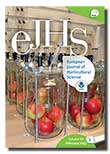

European Journal of Horticultural Science

Impact of Nitrogen Deficiency on Biomass Production, Leaf Gas Exchange, and Betacyanin and Total Phenol Concentrations in Red Beet ( Beta vulgaris L. ssp. vulgaris ) Plants
Authors
G. Salahas1) ; A. Papasavvas1) ; E. Giannakopoulos2) ; T. Tselios3) ; H. Konstantopoulou1) ; D. Savvas4)1)Laboratory of Plant Physiology and Biochemistry, Technological Educational Institute of Mesolonghi, Greece; 2)Laboratory of Physical Processes and Signals, Technological Educational Institute of Mesolonghi,Greece; 3)Department of Chemistry, University of Patras, Greece; 4)Laboratory of Vegetable Crops, Agricultural University of Athens, Greece
Summary
Red beet ( Beta vulgaris L. ssp. vulgaris ) is rich in betacyanins and total phenolics, which are desired by consumers due to their considerable free radical scavenger and antioxidant properties. The aim of the present research was to evaluate the effect of N starvation on accumulation of betacyanins and total phenolics in leaves and roots, as well as biomass production, tissueN concentrations, total chlorophyll content and leaf gasexchange. Leaves of hydroponically cultivated red beet plants subjected to nitrogen deprivation (22.4 mg l-1N in the nutrient solution) over 26 d exhibited a dramatic increase of 262 % in betacyanin concentration, in comparison to adequately-fed plants (224 mg l-1N in the nutrient solution). The corresponding increase of betacyanin concentration in the roots of N-starved red beet was also significantly higher, specifically 225 %. Furthermore, total phenolics concentration under N-starvation conditions increased by 39 % in the leaves and 379 % in the roots, in comparison to standard N supply. These results suggest that the biosynthesis of certain secondary plant metabolites, such as total phenolics and betacyanins, can be stimulated by nutritional stress in red beet plants. Dry leaf and root biomass production in N-deficient plants was significantly restricted by 300 and 250 %, respectively, in comparison with the control plants. The total N concentration decreased by 13 % in leaves and 66 % in roots of N-starved plants. Furthermore, the rates of net CO2-assimilation and transpiration, the stomatal conductance, and the concentration of total chlorophyll, were severely restricted by N- deprivation, indicating that the primary metabolism was severely limited by low nitrogen availability. Our results indicate that, in red beet plants grown under prolonged N-deficiency stress, high amounts of total phenolics and betacyanins accumulate especially in the roots, presumably because the allocation of N to secondary metabolic processes aimed at survival takes strong precedence over N utilization in growth processes.
Download full-text version (PDF 264551 bytes)
Keywords
antioxidant; hydroponics; N-starvation; photosynthesis; secondary plant metabolites
